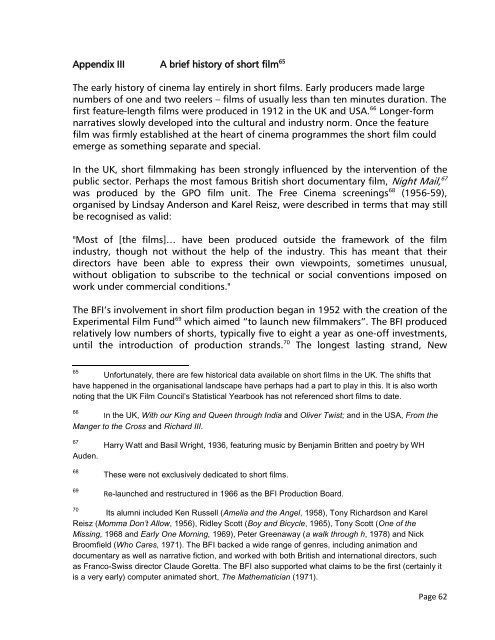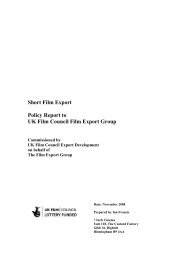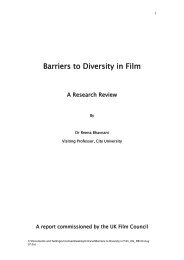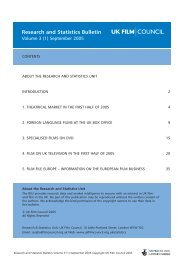Northern Alliance - BFI
Northern Alliance - BFI
Northern Alliance - BFI
You also want an ePaper? Increase the reach of your titles
YUMPU automatically turns print PDFs into web optimized ePapers that Google loves.
Appendix III A brief history of short film 65<br />
The early history of cinema lay entirely in short films. Early producers made large<br />
numbers of one and two reelers – films of usually less than ten minutes duration. The<br />
first feature-length films were produced in 1912 in the UK and USA. 66 Longer-form<br />
narratives slowly developed into the cultural and industry norm. Once the feature<br />
film was firmly established at the heart of cinema programmes the short film could<br />
emerge as something separate and special.<br />
In the UK, short filmmaking has been strongly influenced by the intervention of the<br />
public sector. Perhaps the most famous British short documentary film, Night Mail, 67<br />
was produced by the GPO film unit. The Free Cinema screenings 68 (1956-59),<br />
organised by Lindsay Anderson and Karel Reisz, were described in terms that may still<br />
be recognised as valid:<br />
"Most of [the films]… have been produced outside the framework of the film<br />
industry, though not without the help of the industry. This has meant that their<br />
directors have been able to express their own viewpoints, sometimes unusual,<br />
without obligation to subscribe to the technical or social conventions imposed on<br />
work under commercial conditions."<br />
The <strong>BFI</strong>‟s involvement in short film production began in 1952 with the creation of the<br />
Experimental Film Fund 69 which aimed “to launch new filmmakers”. The <strong>BFI</strong> produced<br />
relatively low numbers of shorts, typically five to eight a year as one-off investments,<br />
until the introduction of production strands. 70 The longest lasting strand, New<br />
65 Unfortunately, there are few historical data available on short films in the UK. The shifts that<br />
have happened in the organisational landscape have perhaps had a part to play in this. It is also worth<br />
noting that the UK Film Council’s Statistical Yearbook has not referenced short films to date.<br />
66 In the UK, With our King and Queen through India and Oliver Twist; and in the USA, From the<br />
Manger to the Cross and Richard III.<br />
67 Harry Watt and Basil Wright, 1936, featuring music by Benjamin Britten and poetry by WH<br />
Auden.<br />
68 These were not exclusively dedicated to short films.<br />
69 Re-launched and restructured in 1966 as the <strong>BFI</strong> Production Board.<br />
70 Its alumni included Ken Russell (Amelia and the Angel, 1958), Tony Richardson and Karel<br />
Reisz (Momma Don’t Allow, 1956), Ridley Scott (Boy and Bicycle, 1965), Tony Scott (One of the<br />
Missing, 1968 and Early One Morning, 1969), Peter Greenaway (a walk through h, 1978) and Nick<br />
Broomfield (Who Cares, 1971). The <strong>BFI</strong> backed a wide range of genres, including animation and<br />
documentary as well as narrative fiction, and worked with both British and international directors, such<br />
as Franco-Swiss director Claude Goretta. The <strong>BFI</strong> also supported what claims to be the first (certainly it<br />
is a very early) computer animated short, The Mathematician (1971).<br />
Page 62
















